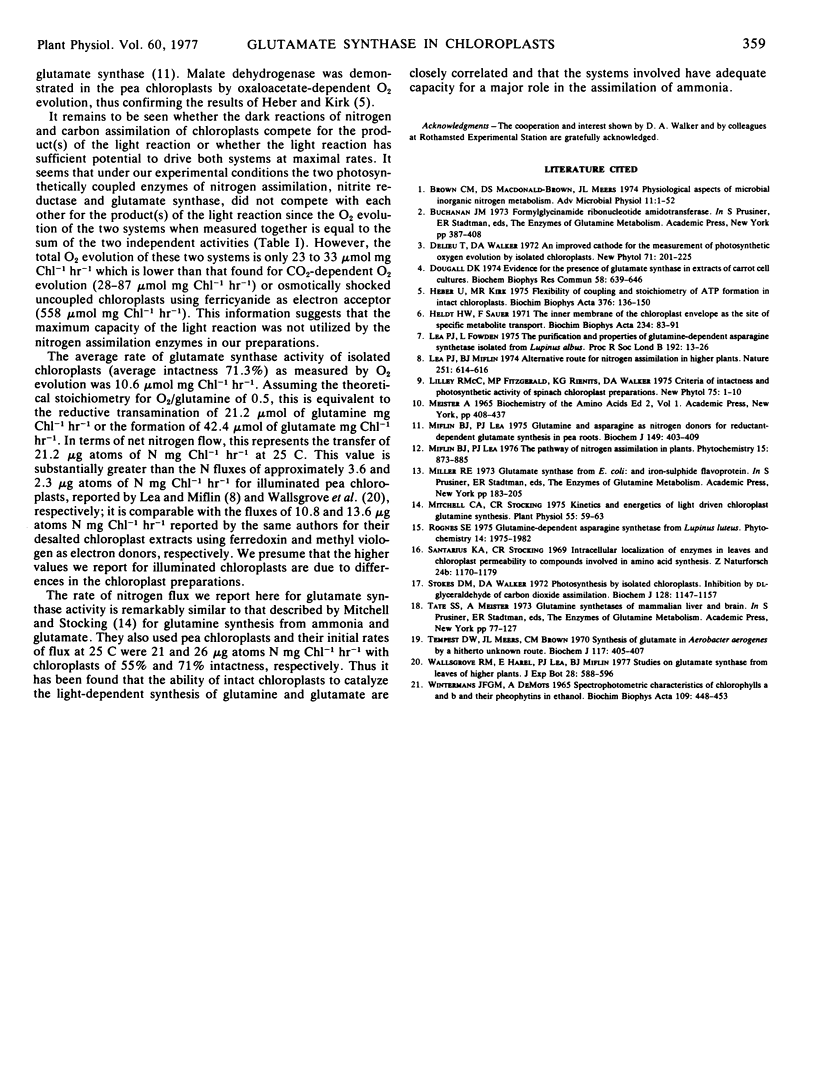Abstract
Illuminated pea (Pisum sativum) chloroplasts actively catalyzed (glutamine plus α-ketoglutarate)-dependent O2 evolution (average of 12 preparations 10.6 μmole mg chlorophyll per hour). The reaction was specific for glutamine and α-ketoglutarate; concentrations of 0.2 mm α-ketoglutarate and 0.6 mm glutamine, respectively, effected half-maximum rates of O2 evolution. The reaction was inhibited by 3-(3,4-dichlorophenyl)-1-1-dimethylurea and did not occur in the dark. After osmotic shock chloroplasts did not catalyze O2 evolution. The reaction was inhibited by azaserine and glutamate but not by 10 mm ammonia, 2.5 mm methionine sulfoximine, or 5 mm amino-oxyacetate; addition of amino-oxyacetate together with aspartate inhibited O2 evolution. Arsenate (3 mm) enhanced O2 evolution. The highest molar ratio for O2 evolved per mole of α-ketoglutarate supplied was 0.40; the corresponding values for glutamine in the absence and presence of 3 mm arsenate were 0.20 and 0.24, respectively. The (glutamine plus α-ketoglutarate)-dependent O2 evolution is attributed to photosynthetically coupled glutamate synthase activity and the activity is sufficient to account for the assimilation of inorganic nitrogen. The low molar ratio for glutamine is discussed.
Chloroplasts also catalyzed (aspartate plus α-ketoglutarate)-dependent O2 evolution but this reaction was inhibited by 5 mm amino-oxyacetate and it was insensitive to azaserine and methionine sulfoximine. This reaction was attributed to transaminase and photosynthetically coupled malate dehydrogenase activities.
Full text
PDF





Selected References
These references are in PubMed. This may not be the complete list of references from this article.
- Dougall D. K. Evidence for the presence of glutamate synthase in extracts of carrot cell cultures. Biochem Biophys Res Commun. 1974 Jun 4;58(3):639–646. doi: 10.1016/s0006-291x(74)80466-3. [DOI] [PubMed] [Google Scholar]
- Heldt H. W., Sauer F. The inner membrane of the chloroplast envelope as the site of specific metabolite transport. Biochim Biophys Acta. 1971 Apr 6;234(1):83–91. doi: 10.1016/0005-2728(71)90133-2. [DOI] [PubMed] [Google Scholar]
- Lea P. J., Miflin B. J. Alternative route for nitrogen assimilation in higher plants. Nature. 1974 Oct 18;251(5476):614–616. doi: 10.1038/251614a0. [DOI] [PubMed] [Google Scholar]
- Miflin B. J., Lea P. J. Glutamine and asparagine as nitrogen donors for reductant-dependent glutamate synthesis in pea roots. Biochem J. 1975 Aug;149(2):403–409. doi: 10.1042/bj1490403. [DOI] [PMC free article] [PubMed] [Google Scholar]
- Mitchell C. A., Stocking C. R. Kinetics and Energetics of Light-driven Chloroplast Glutamine Synthesis. Plant Physiol. 1975 Jan;55(1):59–63. doi: 10.1104/pp.55.1.59. [DOI] [PMC free article] [PubMed] [Google Scholar]
- Santarius K. A., Stocking C. R. Intracellular localization of enzymes in leaves and chloroplast membrane permeability to compounds involved in amino acid syntheses. Z Naturforsch B. 1969 Sep;24(9):1170–1179. doi: 10.1515/znb-1969-0915. [DOI] [PubMed] [Google Scholar]
- Stokes D. M., Walker D. A. Photosynthesis by isolated chloroplasts. Inhibition by DL-glyceraldehyde of carbon dioxide assimilation. Biochem J. 1972 Aug;128(5):1147–1157. doi: 10.1042/bj1281147. [DOI] [PMC free article] [PubMed] [Google Scholar]
- Tempest D. W., Meers J. L., Brown C. M. Synthesis of glutamate in Aerobacter aerogenes by a hitherto unknown route. Biochem J. 1970 Apr;117(2):405–407. doi: 10.1042/bj1170405. [DOI] [PMC free article] [PubMed] [Google Scholar]


